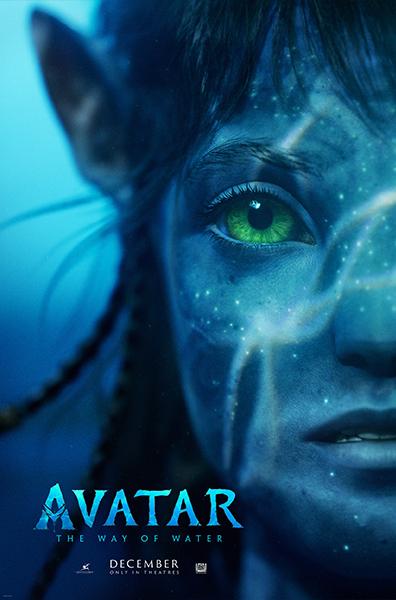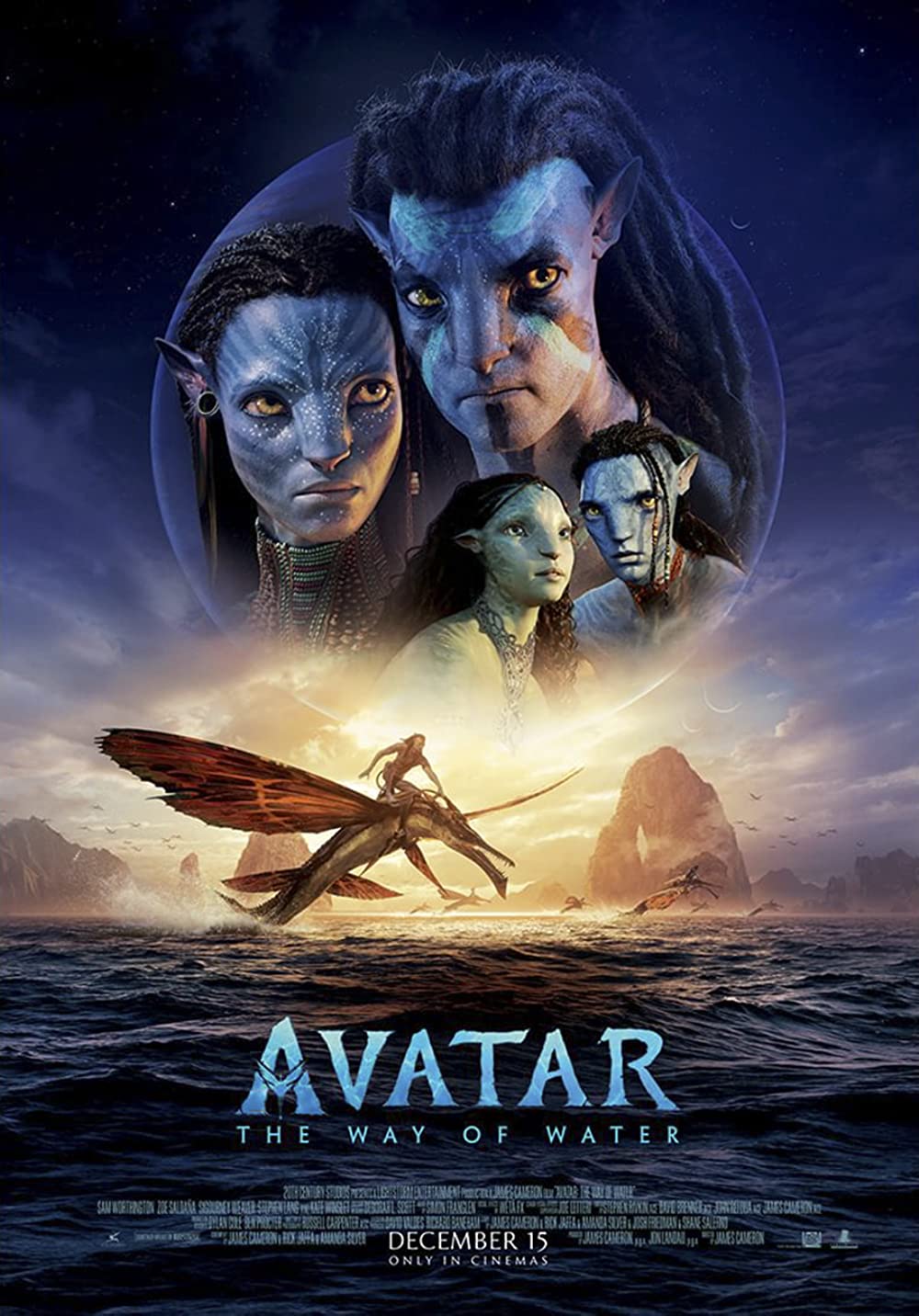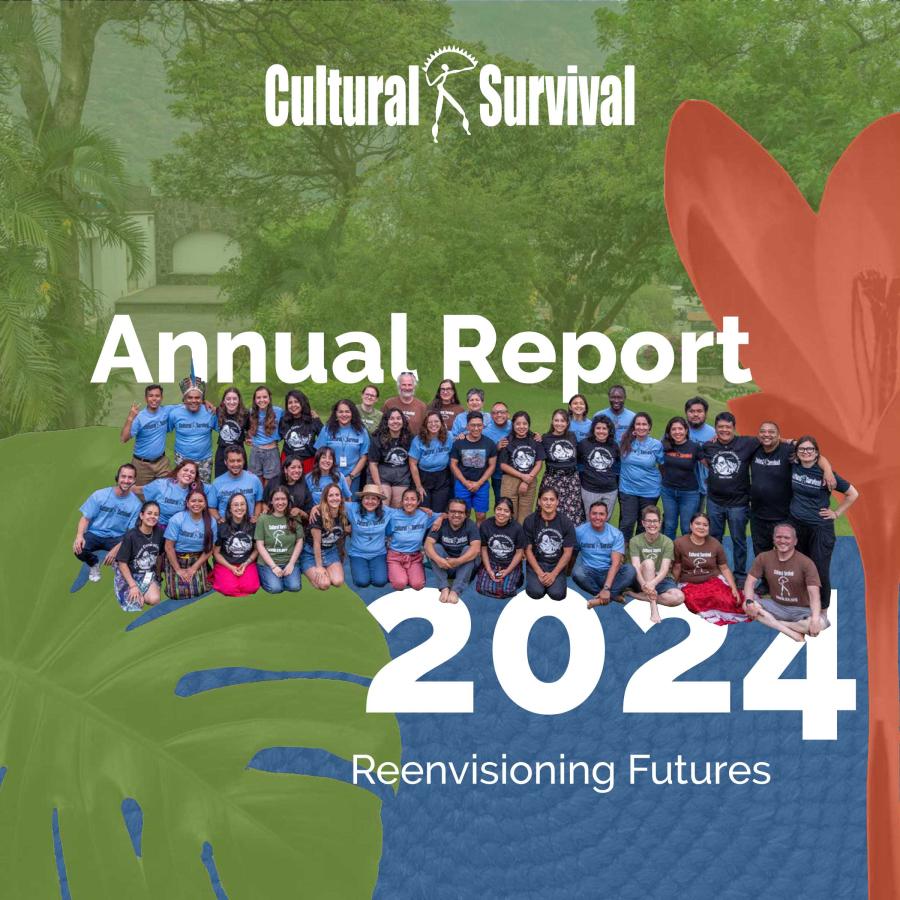
Over the last two months, millions of people around the world have had the chance to sit before an immense flat screen with hundreds of others for three and a half hours, gazing through color-filtering lenses that trick your mind into an experience of enhanced visual depth and perspective, to witness the sequel to a film that its director, James Cameron, has described as a retelling of the colonization of the Americas.
Few spectacles of this intensity, magnitude, or geographic and temporal scope take place on our planet with so many people sharing in the consumption of a mass media product, subjected to a single narrative within the sanitized (and often depoliticized) escapist space of the cinema. If one recognizes film, and mass culture in general, as both representative and generative of active currents within society, then the scale at which this one man’s vision is able to penetrate our shared consciousness is more than worthy of a critical examination.
“Avatar: The Way of Water” does not emerge in a vacuum, but at the inauguration of America’s most intensive commercial season amid a bevy of increasingly unspeakable planetary crises and violence against Indigenous land and water protectors. Indeed, the film is a perverse manifestation of these crises, whose roots lie in the living structures of settler colonialism.
For all of its superficial ecological messaging and pretensions to parable, “Avatar” must be understood as a form of environmental and cultural subterfuge, a bombastic spectacle that feeds the impoverished inner lives of settler and colonizer populations at the expense of actual Indigenous political and environmental movements, many of whom have advocated for a boycott of the film. Subjugated as 99 percent of us are by a vague, transnational elite class, we are all now given the opportunity by Cameron to safely empathize with a revolutionary cause that the West’s commitment to domination and extermination helped squelch long ago.
Heroism and Propaganda
When one goes to the theater, one is paying money for a vicarious experience, much as the ancient Greeks intended in their stage dramas. While film certainly has the power to inspire people, provoke new ideas, and change perspectives in ways deemed “socially positive,” it is well understood that it can also take the form of propaganda. The sophistication of propaganda lies precisely in the ability of a film to induce one’s identification with particular characters or ideas without exposing the guiding ideology; propaganda, in other words, must appear natural and true, empowering and relatable.
The many artistic choices of a creator, among them the essential creation of protagonists and antagonists, can serve the purposes of truthful representation through engagement with moral gray areas and human complexity, or the purposes of propaganda through the perpetuation of binaries. In Greek drama, the vicarious experience of audience members relating to, say, Oedipus Rex, is done with the ultimate social purpose of achieving catharsis, or emotional release and cleansing. The drama’s protagonists demonstrate certain characteristics that audience members can relate to—defiance of fate, desire for power, resistance to authority, the pursuit of vengeance—with the ultimate resolution delivered by a universal or divine force.
The experience of catharsis in Ancient Greece was, however, not achieved purely through spectacle, but through something bodily, something relational that connected not only actors and audience, but audience members with each other and their community. Audiences in ancient Greece, though presented with fiction, were offered something true and felt that could liberate them from their own difficulties and preoccupations, drawing them together into a stronger society. Audiences in today's cinemas were offered a spectacular film that, unfortunately, replaced catharsis with frustration.
So, who are the heroes and villains of “Avatar: The Way of Water,” and how does their portrayal influence our own perceptions of and relations to society? It is embarrassingly obvious to state that Jake Sully and the Indigenous Na’vi are the undisputed heroes, the defenders of the sacred nature of Eywa against the rapacious, relentless colonial onslaught of Quaritch, his military goons, and ultimately the whole of Earth’s humanity. The villains are indeed an appropriate representation of the kind of individuals found in the early wars of European conquest— mercenaries, criminals, and adventurers —as well as scientists producing knowledge for their military employers. The overwhelming majority of humanity’s representatives in the film are these villainous commandos and industrial opportunists, implying one of two things: the diverse inhabitants of Earth are all committed to Pandora’s colonization, or Euro-American neocolonialism on Earth has succeeded in establishing a white supremacist hegemony. In either case, the actual human species (rather than its metaphorical equivalent among the Na’vi) is shown to be irredeemably committed to plunder and conquest.
Though “technologically inferior,” the Na’vi, in contrast, demonstrate qualities of the archetypal “noble savage,” such as a oneness with nature, simplicity, and beauty. These idealized traits serve as much to flatten the characters as to emphasize their virtues, a situation perhaps best captured by the painfully contrived refrain, “The way of water has no beginning and no end. Our hearts beat in the womb of the world. Water connects all things, life to death, darkness to light. The sea gives and the sea takes.”
What this convenient allyship with Indigenous Peoples and the neat, shallow packaging of their philosophies do is instill in the audience a feeling of entitlement to their legacy, a sense that something so simple must be the legacy of all of us. This manifests in the narrative when the immaculately conceived daughter/reincarnation of human biologist Grace Augustine demonstrates a special bond with Pandora and can directly communicate with Eywa. Meanwhile, Na’vi shamans, despite their multigenerational relationship with Pandora through ceremony and subsistence, apparently can’t "develop" such ties. The ocean-dwelling Na’vi instead serve only as expendable bodies and scenery.
Additionally, the quality of her powers, which are used initially for combat, blurs the line between connection to and mastery over nature. In this way, the film promotes the theft of culture within a power fantasy narrative, where the lived histories of struggle and resistance by Indigenous Peoples are condensed and packaged for the audience as another consumable social signifier of virtue in a world of moral absolutes.

The Nuclear Family and White Patriarchy
While the noble savage trope dominates the film, there are numerous examples where the film’s creators seem to inadvertently invest characters with a white positionality. At the end of the first film, Jake is seemingly embraced by the forest Na’vi as their leader, destined to adopt their ways and, messianically, induce an age of peace. “He is ready,” proclaimed Neytiri’s parents, Eytukan and Mo’at, before entrusting him with the fate of their daughter and a tribe. Not at all. When the Sky Peoples return to Pandora with hellish aplomb, Jake, in what is depicted as an act of sacrifice and rationality, forces his nuclear family to abandon their collective over the protestations of Neytiri and their daughters.
It becomes clear within the first 20 minutes that Jake cannot undo his own social conditioning, and he transforms from a white savior to a hyper-individualist. His temperamental decisions consistently override those of Neytiri, a strong woman, beloved daughter of the powerful leader, and a wise shaman mother, who is written into the background, her input into family matters and parenting virtually unheard. As a result, their children act and behave as Americans, reproducing Jake’s way of life. Where Native children, raised with their families and cultures intact, demonstrate respect, obedience, and humility, the children of Jake, not to mention the children of the reef Na’vi, show pride, recklessness, and dishonesty. Ostensibly protecting the community of forest Na’vi, Jake appears ignorant of the Sky Peoples’ long-apparent commitment to total war, and is motivated to save only himself and his nuclear family. Though we never again encounter the forest Na’vi, it can be surmised that they are locked in a desperate struggle with or without the Sully family.
The very fact that, as one critic puts it, “Jake, Neytiri, and their kids are the heart and soul of “The Way of Water,” demonstrates the film’s ignorance of Indigenous ways of kinship, which, according to numerous Indigenous and settler scholars, places community above both family and the individual. Jake’s mimetic commitment to the patriarchal, nuclear family structure of the film’s creators reveals a trope of distinctly white storytelling. As Crystal Echo-Hawk (Pawnee), president and CEO of IllumiNative, said, Cameron “might be telling that story of colonization, but he’s telling it through the lens of a white male.”
The lack of a genuinely critical perspective among nearly all top critics indicates the pervasiveness of the white lens and its associated social markers. The same particularly breathless review noted above serves the film’s ideology perfectly, stating that the family’s “dynamic is very human, with Jake and Neytiri clearly not having a lot of experience when it comes to good parenting and teenagers who struggle with their impulsiveness as well as filling their roles as the most important family in their village.” A critic for the Christian Science Monitor observes, ostensibly without realizing his prescience for propaganda, that “‘The Way of Water’ may be the most expensive ad for family values ever concocted.” The lone family on the run has gripped the American imagination since the days of Western expansion and frontier homesteading.
Spider: The Audience’s Avatar?
As the audience, we are, from the outset, cast as allies to the anticolonial cause of the Na’vi, a position perhaps best embodied by the character Spider, whose white skin, dreadlocks, and blue body paint indicate a youth dissatisfied with his positionality and intent on becoming the Other (an act that Jake Sully accomplished in the first “Avatar” film). Indeed, Spider, as the most prominent human on the side of the Na’vi, functions as an avatar for the audience, a readily empathetic white, fleshy body protruding awkwardly from the computer-generated richness of Pandora.
Spider’s desire to become Na’vi and his affection for Kiri mirror, in a more debased fashion, Sully’s experience in the first film, with the off-putting quality of his cross-species sexual drive tapping directly into the audience’s own manufactured desire for female Na’vi bodies. However, his commitment to the Na’vi is tested by the transparent ploys of his father-not-father, Quaritch. Despite, or perhaps even because of his abrupt inner conflict over the fate of his father, Spider is indispensable in smoothing the affective relation between the audience and the Na’vi. Once captured, he is powerless to stop the colonial machine, and is depicted as occasionally enthralled by the power of the Sky Peoples’ technology. He abets their violent search for the Sullys as an interpreter (a lesson in trust that the scientists supposedly learned in the first film) and ultimately rescues his father-not-father for reasons that even Freud would have trouble parsing. Spider’s extension of humanity to Quaritch, who in the first film was depicted as an irredeemable monster, points to a disturbing shift in the series’ politics toward white innocence.
But being led by Cameron to recognize Quaritch’s humanity through Spider’s act of mercy is not the most dangerous element of the film; the ease with which the audience is led to empathize with the Na’vi is. In a gross refutation of past and present colonial realities, Cameron offers American audiences an apparent carte blanche to adopt the perspective of a subjugated Peoples and cheer for their victory from a theater situated on stolen Indigenous lands. Hundreds of millions of dollars in profit are not being channeled to actual Indigenous communities or causes, but into the pockets of Hollywood executives to privately enrich themselves. Indeed, as Chase Iron Eyes (Oglala Lakota) of the Lakota People’s Law Project has pointed out, the film failed to involve Native writers and cast white people in key Indigenous roles, depriving the film of depth and respect. By making open use of Māori and other Indigenous traditions without engaging those living communities and cultures, the film’s creators fail to construct the prefigurative politics through their enterprise that would see Indigenous Peoples recognized, compensated, and empowered in service to environmental justice. It is clear that Cameron and his ilk in fact prefer their fictional Natives to actual Indigenous Peoples, projecting themselves into the Na’vi personages as enlightened eco-warriors.
The simplistic binary of the film thus aligns with this refusal to engage with the real, messy reality of settler colonialism, the stakes of cultural survival, and the absence of the noble savage among contemporary humanity. It paints, as Cheyenne scholar Autumn Asher Blackdeer describes it, a monolithic portrayal of Indigenous Peoples, lacking the nuanced perspective of contemporary Indigeneity. If the Na’vi simply represent the better angels of our nature, then the failure of the creators to learn from their own characters, to show generosity and make sacrifices, grants the audience the right to do the same. If we had been there when colonization took place, they all think, we would have fought on the side of good. But present-day colonialism, though in a less recognizable form, remains taboo. In this way, the film rings especially hollow, with its status as pure spectacle further entrenched.
Environmental Simulacra
Among the main objects of critics’ misplaced adulation, and, as some have described it, the central character of the film, is the superficially sumptuous ecosystem of Pandora’s ocean. What value is it, we want to ask, to pour millions of dollars into the simulation of a healthy, vibrant, yet unreal biome, while the Great Barrier Reef, not to mention the entire ocean, faces unprecedented catastrophe due to warming, acidification, and overfishing? Though some critics seem all too happy to lend the film credibility as a powerful environmental message, the fact is that a simplistic “Save the Earth” story represents a politics for the 1970s, not the 2020s.
To locate the film’s complicity with the status quo, we must consider the purely material factor of the energy costs and resources that went into the making of the film, the multitude of fossil fuel-driven cars parking in the Regals and AMCs of the country, and the mass production of RealD brand, single use, landfill-bound 3-D glasses—but also the fact that if the makers of this film harbored any belief that their spectacle would inspire the masses to recycle more or plant a tree, they chose to ignore all the evidence of the systemic dysfunction of our unequal and growth-obsessed society driving the planetary crisis. Hasn’t Earth already long been subjected to the same violence as Pandora?
To condemn such naivete even further, the relationship between violence on human bodies and violence on nature is well understood, and a film that so callously capitalizes on the spectacle of war can, in reality, have nothing to do with environmental justice. In this way, “Avatar” is actually a far more socially regressive film than other maudlin, feel-good flicks like “Fern Gully,” “Pocahontas,” or even “Dances with Wolves.”
Violence and Its Portrayal
Over the last several decades, blockbuster films have become more or less synonymous with violence, the same mode of spectacle used to distract and sedate ancient Romans in the Colosseum. Whether a Marvel film or “Harry Potter,” “The Matrix” or “Star Wars,” the highest grossing films of the last several decades revel in violence. “Avatar” is no exception. Like these other films, “Avatar: The Way of Water” facilitates the depiction and consumption of violence by situating it in a good vs. evil binary. This binary serves to devalue the lives of those labeled “evil,” who can be dispatched in droves without compunction, and justify the act of violence by those labeled “good.” Violence then ceases to be a choice and becomes a fact, a totalizing logic that both sides agree to. Now, this is not to say that the narrative doesn’t recognize the Na’vi or the pariah Tolkun as using violence defensively, or that their use of violence is morally equivalent to that of Quaritch within the film’s universe. These arguments are beside the point.
Violence competes with CGI-rendered beauty for the heart of the film’s spectacle, the core element of its watchability. Without a compelling script, rich characters, or philosophical complexity, the film falls back on an appeal to our basest fascination in witnessing destruction. One critic inadvertently captures the meta-violence of the cinematic experience itself when he declares that Cameron “unleashes more than a decade of technological advancements on the viewer.”
In 2010, according to IndieWire reporter Christopher Campbell, Cameron bussed community members from the Amazonian Achuar community, whom he was fundraising for, to watch the first “Avatar” film. For most of them, this was not just their first 3-D film experience, but their first time in a movie theater. Afterwards, community members observed that they found the violence excessive, suggesting that a narrative around dialogue and diplomacy would be better. It is clear, however, that this feedback did not influence Cameron’s vision for the sequel. Instead, the film capitalizes on war, battles, cruelty, and death; the vividness of the film’s depictions of violence can undoubtedly be traumatic, and their analogous relationship to 17th Century colonization renders their consumption as entertainment almost unconscionable. It accustoms its viewers to not only the experience of violence but to its philosophical justification, rendering the concept of diplomacy that much less appealing. That the violence is, like the environment and people it destroys, sumptuous and lifelike, makes it that much more desensitizing and nihilistic.
So, why use a two-dimensional story about one of the most tragic dynamics in human history as a vehicle for Cameron’s sophisticated CGI technologies? Numerous Indigenous critics have already weighed in on this. While we are more inclined to treat Cameron as an ignorant elite with a white savior complex rather than a master manipulator of our collective consciousness, the decisions and resources that permitted this film remain unsettling. The technology used to create this film has elicited a ceaseless parade of “oohs” and “ahs” acclaim for the achievement in virtual simulation and immersive experience. But the objects of this simulation are dreams, white men’s dreams, of nature and Indigeneity eradicated by colonial violence.
The film is thus, in our estimation, the ultimate act of possession, a form of colonial mastery that cannot recognize itself as such. It merely imitates Indigenous spiritual and ecological life, yet claims to capture a fully-realized world. It presents a real fantasy and a fantastical reality that both undermine fundamental truths about reality and history. It draws upon the vicious and wretched destruction of thousands of diverse Peoples for its inspiration but attributes authorship to one man. The film is, contrary to those who would find an environmental message in it, fundamentally anti-nature and anti-Indigenous. For Cameron, these are simply categories to be reproduced, distilled, mimicked, and traded in. They are objects to be rendered into virtual format—both in terms of pure data, and as abstracted experience—as climate change and biodiversity loss make every one of us a potential customer for simulated hope.
The Empty Spectacle
To bring this bitter critique to a close, we declare that the shameless coloniality of the film is undeniable, from its development, script, and use of technology to its reception and political economy. The fact that hundreds of film critics are able to casually disparage Cameron’s story as “good enough,” “uninspired,” and “paper-thin,” or praise its “themes of empathy and feeling” and “ardent, cornball grandeur” points to a full derealization of Indigenous experiences, its diminishment down to a product for our entertainment. In this dynamic there is something dark, indeed even cannibalistic, because the box office doesn’t lie: there is a craving among Americans for this perversion of reality, for this masturbatory romance with our own suppressed ghosts. We are being delivered the emotional thrill that might fill our emptiness in the form of “thrilling play, risky adventures, and rousing combat.” We are presented with another thing to consume.
Appropriately, one critic praises Cameron for “finding new worlds to feast on from underwater seascapes to new digital effects frontiers.” Surely such phraseology was not alien to the conquest- and technology-obsessed world of 17th Century Europe, yet here we are again, strapped inside an entertainment cyclotron, reliving these and other horrors, while nature is pillaged just outside. “Avatar” and its sequel are little more than regurgitations of the American national myth, deformed to nourish settler innocence and stun us, through spectacle, into obedient submission. We have watched “Avatar: The Way of Water,” and regrettably admit that we are the worse for it.
--Nicholas Parlato is an interdisciplinary PhD student at University of Alaska Fairbanks. Born and raised in Baltimore, Maryland, he has lived and traveled extensively in the circumpolar north and currently conducts research on environmental governance in the Russian-American Arctic. With a longstanding interest in media culture and criticism, he believes that debate around popular art and entertainment is a powerful tool for understanding society and politics.
Vera Solovyeva PhD (Sakha) is a researcher in the Environmental Science and Policy Department, George Mason University, Fairfax, Virginia. She was born and raised in the Sakha Republic, Russia. Her research focuses on how Indigenous Peoples maintain and develop their cultures and traditions in a contemporary world that is rapidly changing under the pressure of factors such as globalization and climate change. She believes that Indigenous Peoples' knowledge and values can help the world be better for all people.
Images: Official "Avatar: Way of the Water" movie posters.



